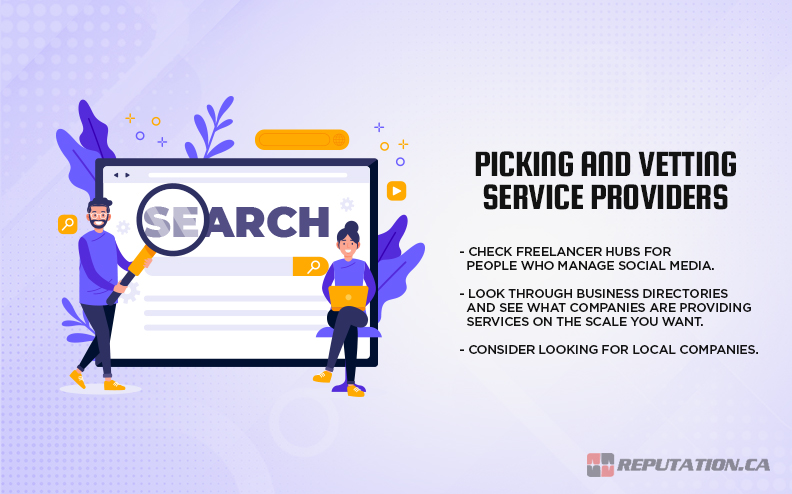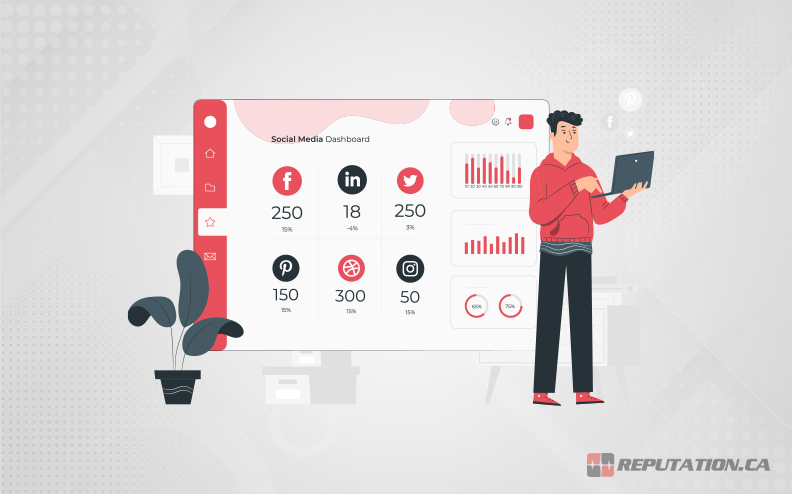One of the hardest parts of running social media profiles for your business is just how frequently you need to keep them up to date. According to studies:
- You should post on Facebook no less than three times per week and no more than twice per day.
- You should post new content to TikTok 1-3 times per day for optimal engagement.
- Twitter demands the bare minimum of once per day, but for optimal engagement, you should post a whopping 15-20 times per day.
And the list goes on! Every social network, from YouTube to Pinterest to Instagram, has an optimal frequency to make use of the algorithms and engage the largest slices of your audience with each post. While the numbers can change over time, they tend to stay in the same basic ranges. One thing is certain: it’s a lot of content. So much so that managing a business social media presence – including monitoring and moderating comments, engaging with users, providing customer service, and posting content – is a full-time job.
This is all part of why, when we recommend which social networks your business should use, we always start off with “as many as you can keep up to date.” Not having a profile on a popular social network is worse than having one, but having an abandoned profile is worse than not having one at all.
It’s no wonder that many businesses, especially smaller businesses operating on tighter budgets, don’t want to spend the time to manage a social media presence. Even just using the bare minimum of Facebook and Twitter is a huge time commitment and requires the input of everyone, from the business owner to the writers and graphic designers responsible for creating content.
And none of this even considers paid advertising on these platforms!
The solution, as with many such situations, is to outsource your social media updates. Paying a company or a contractor to handle it for you is cheaper, more efficient, and faster than doing it yourself. Plus, it frees up your valuable time to invest in more important avenues of business growth.
You can’t simply abandon or ignore social media. Too many people use it, and it forms so much of the core of your online reputation that leaving it behind is a recipe for disaster. If you want to sculpt a positive reputation, engage with customers and the people who leave reviews, and ensure that no one can impersonate you online, you need to keep your social media running. It really seems like outsourcing is one of the best options available.
The Risks of Outsourcing
Before we get into exactly how to outsource your social media, let’s talk about the ways it can go wrong.
To be clear, we’re not trying to warn you away from outsourcing. Quite the opposite, in fact. Outsourcing can be a great idea and is efficient from a time and monetary standpoint. You can also leverage higher skill levels and experience levels when you hire someone to outsource your social media rather than trying to put together a DIY strategy.

That said, there are risks with outsourcing something so crucial to your reputation and your customer connections. A rogue social media manager can do a lot of damage before you have a chance to respond, and a poor-quality social manager can stifle growth in ways you might not even realize. So, we’re going to talk about the risks up-front to empower you to both make your own decision about outsourcing and to keep an eye out for the problems that can arise.
Risk #1: Hiring the wrong person for the job.
There are a lot of people out there who start as graphic designers or content writers and who decide to list social marketing on their skills list. When you go to a site like Upwork or Freelancer to hire a contractor, you get a lot of these people responding to your inquiries. If you hire one, what do you have?
Someone who doesn’t really know what they’re doing.

A good social media manager does a ton for you. They monitor trends, in the industry, in your audience, and in the network. They keep up to date with best practices, memes, and techniques. They read and report on your social metrics with nuance and detail. They identify, monitor, engage with, and copy influencers. They write compelling content, create compelling images, and may even make compelling landing pages. They moderate comments and engage with your audience. It’s a lot of work!
Can a writer do that? Can a graphic designer do that? Maybe, but probably not. You need someone with social marketing experience, not just content creation experience. In fact, hiring a single person to do all of the above is largely impossible. At a minimum, you need a person to manage the site and a person to create the content, if not a whole team to do all of the above.
Risk #2: You prioritize price over service.
You get what you pay for. When you’re trying to pay a low rate to handle your social media, you’re going to be getting service commensurate with your pay rate. Maybe you’ll find that hidden gem who knows what they’re doing but not what they’re worth, but most of the time, you find people who either don’t know or aren’t very good at putting theory into practice.

On the flip side, it’s entirely possible to pay too much. Plenty of people charge more than they’re worth, and even if you pay a premium for premium service, you need to be aware of the ROI from social media. Even an excellent social media campaign has limits on how much it can earn you in return, and if you’re paying too much, it’s not cost-effective.
Risk #3: Micromanagement and the lack of trust.
Outsourcing means truly outsourcing. You need to find a manager or agency you can trust to know what they’re doing, to work with you effectively. If you need to oversee, edit, and micromanage everything they do, then you’re not really saving yourself the time and effort of running your social presence, now are you?
It’s good to have communication and oversight, but you need to be able to trust that your chosen social media management service is capable of handling your social media effectively without constant oversight.

These are the biggest roadblocks to effective social media outsourcing. As long as you can avoid them, you should be able to succeed with outsourced social media updates. Which leaves one question: how, specifically, can you do it?
Outsourcing Step 1: Knowing What You Need
There are two major decisions you need to make before you can even start looking for companies, contractors, or services to outsource your social media.
How many and which networks are you going to be using?
The first major choice is which social networks you’re going to be using. Are you sticking with the bare minimum of Facebook and Twitter? Are you adding in 1-2 others, like Instagram, LinkedIn, or Pinterest? Are you planning to go whole-hog with multimedia and use TikTok, YouTube, and even podcasting? The more you want to use, the more expensive, comprehensive, and time-consuming your social media outsourcing will be.
How much or how little service do you want?
There are several different kinds of social media outsourcing you can consider.
At the “lowest” level, you have strategic outsourcing. With strategic outsourcing, you hire someone to set up and optimize your social media profiles, develop an overall content strategy for you, and set up analytics reporting so you can monitor your own metrics. That’s it; you handle all of the content creation, posting, and scheduling, and only reach out to the outsourcer every few months, every quarter, every six months, or every year for a review and adjustment to keep your strategy on track.
At the middle level, you have a close working relationship with your social media consultant. They handle everything from setup to posting to monitoring and engaging with customers. However, you still have a close relationship with them and guide what they’re doing. You may have weekly or even daily communications with them, you may have your staff be the ones providing the content that they post, and so on. This is almost like an employee relationship rather than a B2B service outsourcing and is often treated as such.

At the “upper” level, you have full outsourcing. You pick a company that specializes in managing social media for businesses, you hand them the keys to your profiles, and you let them do their thing. They have more knowledge, experience, and resources than you do, and all you need to do is work with them to guide your overall messaging.
This third tier is generally the most effective but can give many business owners anxiety about not being in total control over the voice and presence of their brand. It requires a lot of close and iterative review, the option to veto and oversee content, and a lot of trust. It also tends to be more expensive than the other kinds of service.
In the end, the decision between these broad tiers of service (and finding middle ground options between them) is all up to you.
Outsourcing Step 2: Picking and Vetting Service Providers
Once you’ve made your two primary decisions above, you can start looking for service providers. Luckily, you’re spoiled for choice. Unluckily, there are a ton of low-quality providers out there you’ll have to sort through.

- Check freelancer hubs for people who manage social media. Vet them by checking their reviews, talking to past clients, and asking for specifics they would only know if they’ve closely handled social media for companies in the past.
- Look through business directories and see what companies are providing services on the scale you want. You can often search for social media consulting or outsourcing as well.
- Consider looking for local companies. A local company for a local business can be a great match because they know your area, but you need to make sure they can provide high-quality service as well.
Vetting a company can be tricky, unfortunately. Often, the best way to do it is a trial run, after which you monitor the quality of their work and decide whether or not to sign a longer contract.
Outsourcing Step 3: Developing a Working Relationship

Any time you’re handing over the keys to a business process to an outsourced service provider, there will be an adjustment period. It’s important to not make any rash decisions; give them time to break in and learn your preferences, and give yourself time to get used to the communication methods they use. Sometimes there will be obvious incompatibilities or red flags, and it’s fine to cancel in these cases. Other times, you might just need to adjust to one another before you can fully settle into a good working relationship.
Outsourcing Step 4: Reviewing Output and Metrics
Once you’ve been working with your chosen company for a while, you can start to review what they’ve done. Ask yourself questions such as:
- Are they posting frequently enough for the sites they’re managing?
- Are they adequately providing reports on their performance?
- Are they responding to customers appropriately and keeping them engaged?
- Are you receiving growth or a return on investment that makes it worthwhile?
- Are there any red flags you might see that turn you away from their service?

Sometimes, you’ll find their service to be exactly as you expect. Other times, they will out-perform your expectations. In some cases, they’ll underperform. Occasionally, there will be a good reason, and you can cut them some slack. Other times, you need to cut them loose. It’s all a judgment call you’ll need to make.
If you’re currently in the market for a company to manage your social media presence and help boost your online reputation, we can help. Please, feel free to contact us at any time to learn more about our social media updating service today.











